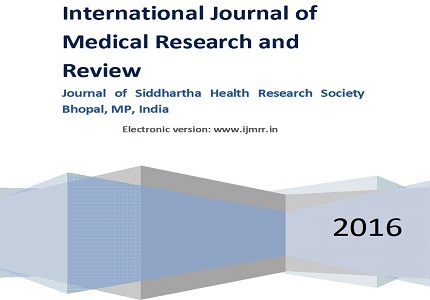Lipid profile in pre-eclampsia in comparison with normal subjects
Abstract
Introduction: The present study was designed to evaluate the association of dyslipidemia (abnormal lipid metabolism) in pre-eclampsia in comparison with non pregnant women, normotensive pregnant women and post partum subjects.
Material ad Methods: This study was conducted on 200 subjects who were further divided in four groups (50 subjects in each group). The four groups were non pregnant subjects, normotensive pregnant subjects, pre-eclamptic patients and post partum subjects. Each serum sample from different groups was evaluated for total cholesterol (mg/dl), HDL-cholesterol (mg/dl), LDL-cholesterol (mg/dl), VLDL-cholesterol (mg/dl) and triglyceride (mg/dl).
Result: On comparison of non pregnant subjects, normotensive pregnant subjects and post partum subjects with pre-eclamptic patients, the levels of total cholesterol, LDL cholesterol, VLDL cholesterol and triglycerides were found to be significantly increased (p values ≤ 0.001) and that of HDL cholesterol levels were found to be statistically significantly (p values ≤ 0.001) in pre-eclamptic patients.
Conclusion: Deranged lipid metabolism in pre-eclampsia is associated with development of atherosclerotic diseases which increases the morbidity and mortality in mother as well as foetus. The various factors responsible for development of dyslipidemia and its prevention need to be studied and evaluated.
Downloads
References
Vanderjagt DJ, Patel RJ, El-Nafaty AU, Melah GS, Crossey MJ, Glew RH. High-density lipoprotein and homocysteine levels correlate inversely in preeclamptic women in northern Nigeria. Acta Obstet Gynecol Scand. 2004 Jun;83(6):536-42.doi: https://doi.org/10.1111/j.1600-0412.2004.00513.x.
Mutlu Turkoglu U, Ademoglu E. Imbalance between lipid peroxidation, antioxidant status in preeclampsia. Gynecol Obstet Invest. 1998;46:37–40.doi: https://doi.org/10.1159/000009994.
Qiu C, Phung TT, Vadachkoria S, Muy-Rivera M, Sanchez SE, Williams MA. Oxidized low-density lipoprotein (Oxidized LDL) and the risk of preeclampsia. Physiol Res. 2006;55(5):491-500. Epub 2005 Dec 12. https://www.biomed.cas.cz/physiolres/pdf/55/55_491.pdf.
Enquobahrie DA, Williams MA, Butler CL, Frederick IO, Miller RS, Luthy DA. Maternal plasma lipid concentrations in early pregnancy and risk of preeclampsia. Am J Hypertens. 2004 Jul;17(7):574-81.doi: https://doi.org/10.1016/j.amjhyper.2004.03.666.
Cekmen MB, Erbagci AB, Balat A, Duman C, Maral H, Ergen K, et al.Plasma lipid and lipoprotein concentrations in pregnancy induced hypertension. Clin. Biochem. 2003; 36(7):575-8.
Kokia E, Barkai G, Reichman B, Segal P, Goldman B, Mashiach S. Maternal serum lipid profile in pregnancies complicated by hypertensive disorders. J Perinat Med. 1990;18(6):473-8.doi: https://doi.org/10.1515/jpme.1990.18.6.473.
Taylor RN, Roberts JM. Endothelial cell dysfunction. In: Linhheimer MD, Roberts JM, Cunningham FG, eds. Chesley’s Hypertensive Disorders in Pregnancy. 2nd ed. Stanford, CT: Appleton & Lange; 1999: 395–429.
Adiga U, D'souza V, Kamath A, Mangalore N. Antioxidant activity and lipid peroxidation in preeclampsia. J Chin Med Assoc. 2007 Oct;70(10):435-8.doi: https://doi.org/10.1016/s1726-4901(08)70034-0.
Gohil J.T. et al, Estimation of Lipid Profile in Subjects of Preeclampsia, The Journal of Obstetrics and Gynecology of India (July–August 2011) 61(4):399–403.doi: https://dx.doi.org/10.1007%2Fs13224-011-0057-0.



 OAI - Open Archives Initiative
OAI - Open Archives Initiative


